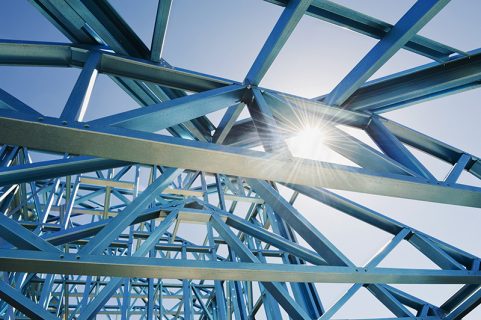Sheet metal is widely used in the construction of residential, commercial, and industrial buildings. It’s a durable and malleable material that can be fabricated precisely to fit your needs. It’s also lighter than wood and concrete, making it safer and more versatile.
Sheet metal can be created using various metal types, such as aluminum, galvanized steel, stainless steel, magnesium, carbon steel, and copper. These metals vary in weight, strength, and use, but they’re all reliable in building different structures.
Here are six ways to use sheet metal in building construction.
1. Roof Trusses
A roof truss holds the shape and maintains the structural integrity of a roof. It’s a joint frame that supports horizontal, vertical, and inclined loads. For residential buildings, the traditional material used is timber. However, modern construction has shifted to metal.
A roof truss should be tough and lightweight at the same time. The structural framing and load-bearing walls of a building carry its weight, so the lighter it is, the safer it will be. The most common metals that industrial roofing contractors use for roof trusses are aluminum and stainless steel due to their maximum durability and lightweight.
The bars used for creating roof trusses all come from sheet metal. Sheet metal, is fabricated to create angle bars, tubular metals, and furring.
If you need to set up roof trusses for your building, you can check out metal fabricators that offer excellent services, such as Alroys sheet metal services.
2. Structural Framing

For hundreds of years, timber has been the most common material for structural framing. However, most timbers are often too heavy. They’re prone to termite infestation as well, especially when not treated.
Sheet metal is used to form different bars, tubers, and furring for a lightweight and resilient structural framing. Steel and aluminum are commonly used metals, particularly for tiny houses on wheels. They’re an excellent alternative to timber, considering weight and durability.
Furthermore, these metals provide enough reinforcement for windows and door framing. Steel reinforcement is even required for constructing shipping container offices and houses when the walls are cut out.
3. Steel Decks And Roofs
Sheet metals are pliable, making them perfect for creating various materials for constructing buildings. Some of these are steel decks and roofs. These corrugated metal sheets are used for multiple structures.
A steel deck is an affordable alternative to traditional concrete slab reinforcement. Its strength relies on its corrugation. Despite being less expensive, the steel deck is equally tough compared to conventional reinforced concrete, which is lighter. It’s ideal for residential and commercial buildings, especially if you have a limited construction timeframe.
Like steel decks, metal roofs are made of corrugated sheet metal. Although these are known for roofing, some homeowners prefer to use them for exterior siding for an industrial look. You may use them for sheds and other small structures too. FastMetals carries sheet metal to meet your needs.
4. Beams And Columns
Metal beams and columns are commonly used for constructing industrial buildings, like factories, warehouses, and hangars. In addition, they’re used for houses with industrial-themed exterior and interior design.
Beams and columns are often made with galvanized tubular steel. You can have them fabricated by your chosen sheet metal manufacturer according to the length, width, and tensile strength specified by the structural or civil engineer. This method allows faster construction since they’re ready to be bolted and assembled on site.
Moreover, steel beams and columns are used for glass houses for a sleek and sharp look. They’re often painted black to emphasize the straight lines and edges of the structure, suitable for industrial-themed homes.
5. Canopies And Awnings
Another innovative use of sheet metal in construction is creating canopies and awnings. These are parts of a building that protrude, and, therefore, need a sturdy reinforcement that requires fewer or no columns.
Door and window awnings are installed for additional protection from sunlight and rain. Its frame is often tubular steel, and the roof is made from bent or corrugated sheet metal. However, they can be made of transparent polycarbonate sheets.
On the other hand, canopies are often built to provide shade for porches and other outdoor living spaces. Their columns are best made with galvanized tubular steel for stronger reinforcement.
Air Ducts
Sheet metals are widely used for air ducts. This is part of the building’s heating, ventilation, and air conditioning (HVAC) system. The vents let the structure breathe.
Since air ducts are prone to moisture and mold, non-corrosive and stainless sheet metals are excellent. Aluminum and galvanized steel are ideal for air ducts due to their protective layer that prevents mold and rust from forming.
Plus, sheet metal is the most pliable material for creating air ducts. It can easily be bent to form the appropriate shape, sizes, and curves to fit the given space.
Conclusion
Sheet metal is an excellent construction material due to its durability, resilience, flexibility, and sustainability. It can be fabricated to form various bars and sheets needed to strengthen a building.

